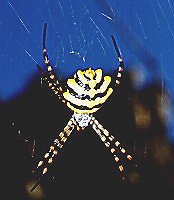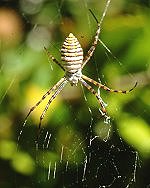|
Argiope (garden spiders)
Life
> Eukaryotes
>
Opisthokonta >
Metazoa
(animals) > Bilateria > Ecdysozoa > Panarthropoda > Tritocerebra >
Arthropoda > Arachnomorpha > Cheliceriformes > Chelicerata > Euchelicerata
> Arachnida > Araneae
> Araneomorpha > Family: Araneidae
Argiope is one of the most familiar genera of orb
web spiders. Being diurnal, garden spiders are colourfully marked, the carapace
silver and the legs banded. The aposematic (warning) yellow and black
colouration of the abdomen remind birds that they are unpalatable.
The Argiope web normally has two zig-zag bands of
silk radiating outwards from the hub (centre) to the bottom corners of the web.
There may be four of these bands in some species while some juveniles may
construct a spiral. These are called stabilimenta and serve various functions;
stabilize and strengthen the web, make the web visible perhaps serving as a
decoy for birds, or also to reflect ultraviolet light thereby deceiving and
attracting insects.
The spider sits head down with its legs positioned in
pairs, forming a cross with the two anterior (front) pairs resting on the
stabilimenta.
"Argiope" means "silver face" with reference to the silver
prosoma and may refer to a Greek mythological person.
Species indigenous to southern Africa
|
Argiope anomalopalpis |
|
|
Argiope aurocincta |
|
|
Argiope
australis
Argiope australis (25mm body
length) has a scalloped abdomen with yellow and black bands. On the Cape
Peninsula some spiders have orange and black bands. Argiope
australis occurs over most of Africa except in forests from South Africa
northwards to north-east Africa. It is commonly seen from about January to
June on its web amongst low base vegetation, within a metre from the ground.
Males are tiny, measuring 5.5mm, and can often be seen in or near the
females web. Juvenile females appear to have a more slender build. |

|
|
Argiope flavipalpis |
|
|
Argiope levii |
|
|
Argiope lobata |
|
| Argiope trifasciata |
 |
Text and images by Norman Larsen
©. |
